Subaru Corporation
Subaru Corporation (Japanese: 株式会社SUBARU, Hepburn: Kabushiki-gaisha Subaru), formerly known as Fuji Heavy Industries, Ltd. (Japanese: 富士重工業株式会社, Hepburn: Fuji Jūkōgyō Kabushiki-gaisha) (FHI) from 1953 to 2017, is a Japanese multinational corporation and conglomerate primarily involved in both terrestrial and aerospace transportation manufacturing. It is best known for its line of Subaru automobiles. The company's aerospace division serves as a defense contractor to the Japanese government, manufacturing Boeing and Lockheed Martin helicopters and airplanes under license. This same division is a global development and manufacturing partner to both companies.
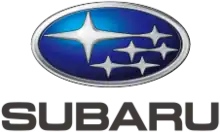 | |
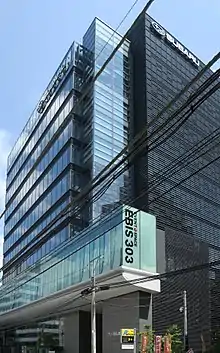 Subaru corporate headquarters building | |
Native name | 株式会社SUBARU |
|---|---|
Romanized name | Kabushiki-gaisha SUBARU |
| Formerly | Fuji Heavy Industries, Ltd. (1953–2017) |
| Type | Public K.K. |
| TYO: 7270 TOPIX Large 70 Component | |
| Industry | Automotive, transportation equipment manufacturing, defense |
| Predecessor | Nakajima Aircraft Company |
| Founded | 15 July 1953 |
| Headquarters | , Japan |
Key people | Yasuyuki Yoshinaga (Chairman) Tomomi Nakamura (President & CEO) |
| Products | Automobiles, aircraft, industrial engines, garbage trucks |
| Owners | Toyota (20.00%) TMTBJ investment trusts (7.57%) JTSB investment trusts (5.33%) Mizuho Bank (1.31%) Sompo Japan Nipponkoa Insurance (1.27%) |
| Website | Subaru Corporation |
History
Fuji Heavy Industries traces its roots to the Nakajima Aircraft Company, a leading supplier of airplanes to the Japanese government during World War II. At the end of World War II, Nakajima was broken up by the Allied Occupation government under keiretsu legislation, and by 1950 part of the separated operation was already known as Fuji Heavy Industries.
FHI was incorporated on July 15, 1953, when five Japanese companies, known as Fuji Kogyo, Fuji Jidosha Kogyo, Omiya Fuji Kogyo, Utsunomiya Sharyo, and Tokyo Fuji Sangyo, joined to form one of Japan's largest manufacturers of transportation equipment.
By late 1980s, the company was a major supplier of military, aerospace and railroad equipment in Japan, but 80% of its sales came from automobiles. Sales in 1989 fell 15% to US$4.3 billion.[1] In 1990, the company faced a loss of over US$500 million. Industrial Bank of Japan Ltd., the main bank of the company, asked Nissan Motor, which owned 4.2% of the company, to step in. Nissan sent Isamu Kawai, the president of Nissan Diesel Motor Co., to take charge of FHI.[2] In 1991, FHI started contract-manufacturing Nissan Pulsar (Nissan Sunny in Europe) sedans and hatchbacks.[3]
Currently, the Subaru Corporation makes Subaru brand cars, and its aerospace division makes utility and attack helicopters for the Japanese Self Defense Force, trainers, unmanned aerial vehicles, and the center wings of Boeing 777 and Boeing 787 jets. In the past, FHI made parts for the Raytheon Hawker and Eclipse Aviation business jets.
In 2003, the company adopted the logo of its Subaru automobile division as its worldwide corporate symbol.[4]
On October 5, 2005 Toyota purchased 8.7% of FHI shares from General Motors, which had owned 20.1% since 1999.[5] GM later divested its remaining 11.4% stake on the open market to sever all ties with FHI. FHI previously stated there might have been 27 million shares (3.4%) acquired before the start of trading by an unknown party on October 6, 2005, and speculation suggested a bank or perhaps another automaker was involved. After the purchase, Toyota announced a contract with Subaru on March 13, 2006 to use the underutilized Subaru manufacturing facility in Lafayette, Indiana, USA as well as plans to hire up to 1,000 workers and set aside an assembly line for the Camry, beginning in the second quarter of 2007.
In June 2014, the company entered into a contract with Boeing Commercial Airplanes, as one of five major Japanese companies contracted, to build parts for Boeing's 777X aircraft.[6]
In May 2016, Fuji Heavy Industries announced that it would change its name to Subaru Corporation, with the change effective on April 1, 2017.[7][8][9]
Divisions
Subaru has two main divisions:
- The automobile division, Subaru.
- The aerospace division is a contractor for the Japan Defense Agency and markets and sells both commercial and defense-related aircraft, helicopters and target drones. For the Japan Ground Self-Defence Force it has built the Bell UH-1 Iroquois, Bell AH-1 Cobra and Boeing AH-64 Apache helicopters. It will also be responsible for providing maintenance for the Bell-Boeing V-22 Osprey tilt rotor aircraft.[10][11] This division previously built the FA-200 Aero Subaru and is currently participating in the Airbus A380, Boeing 777, Boeing 787, Hawker 4000 and Eclipse 500 programs, and supplies parts for Boeing 737, Boeing 747 and Boeing 767.
Former divisions
- Subaru discontinued the production of buses and railroad cars in 2003.
- The eco technology division manufactured and sold garbage trucks, robot sweepers, and wind turbines.
- Discontinued in 2017, the Subaru Industrial Power Products division manufactured and sold commercial engines, pumps and generators which were formerly under the Subaru-Robin and Robin brands. Subaru's industrial products division, began manufacturing "Star" engines for Polaris Industries snowmobiles in 1968 but engine manufacturing operations ended in 1998 when Polaris Industries started to build their own Liberty two-stroke engines. Subaru remains an invested partner with, and supplier of pistons to, Polaris. Subaru has provided more than 2 million engines used in Polaris snowmobiles, ATVs, watercraft and utility vehicles.[12]
Leadership
Past presidents
- 1953–1956 — Kenji Kita
- 1956–1963 — Takao Yoshida
- 1963–1970 — Nobuo Yokota
- 1970–1978 — Eiichi Ohara
- 1978–1985 — Sadamichi Sasaki
- 1985–1990 — Toshihiro Tajima
- 1990–1996 — Isamu Kawai
- 1996–2001 — Takeshi Tanaka
- 2001–2006 — Kyoji Takenaka
- 2006–2011 — Ikuo Mori
- 2011–2018 — Yasuyuki Yoshinaga
Products
Small automobiles
Bus models
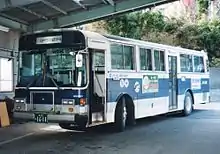
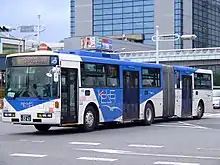
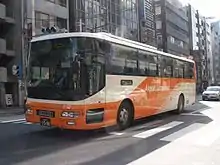
- R13
- 13
- 3A/3B/3D/3E
- R1/R2
- R14
- 14
- 4B/4E
- R15
- 5B/5E
- R1/R2/R3
- HD1/HD2/HD3
- Double-decker
- R16
- 6B/6E
- H1
- R17
- 7B/7E
- 7HD
- 7S
- R18
- 8B/8E
- R21
- 1M/1S
Aircraft

- Fuji FA-200 Aero Subaru (1965) - monoplane/light aircraft
- Fuji/Rockwell Commander 700 (1975) - light transport
- Fuji KM-2 (1962) - light primary military trainer
- Fuji LM-1 Nikko (1955) - light communications military aircraft
- Fuji T-1 (1958) - intermediate military jet trainer
- Fuji T-3/KM-2 (1974) - primary military trainer
- Fuji T-5/KM-2 Kai (1984) - basic military trainer
- Fuji (Bell) UH-1H/UH-1J (1970s/1980s) - utility helicopter & troop carrier
- Fuji T-7/T-3 Kai (1998) - primary military trainer
- Fuji TACOM UAV.[13]
- Fuji (Boeing) AH-64DJP Apache (2001)
- Subaru-Bell UH-X - Ongoing project to meet the JGSDF's requirement for a UH-1J replacement. Bell Helicopter is Fuji's foreign partner in the competition.[14] A variant of the UH-X may also ultimately fill the JMSDF's recently (October 2014) revealed requirement for a New Patrol Helicopter (to enter service in 2022).
Railway rolling stock
Some products were built in Utsunomiya Sharyo Era(1950-1955).
Japan
- 31 , 32 , 37 , 54 types
- JR Hokkaido - KiHa 150 , KiHa 201 , KiHa 281 , KiHa 283 , and KiHa 261 series.
- JR East - KiHa 100 and 110 series
- JR Central - KiHa 85 series
- JR Shikoku - 2000 series
- Mōka Railway - Mooka 14 type - The final products of railway rolling stock as Subaru
- Chizu Express - HOT7000 series
- JNR - 10, 12 , 14 , 24 , 50 series
- JR East - E26 series
- EMU
- JNR - 70 , 80 series
- Tobu Railway - 300 , 2000 , 5000 , 6050 , 8000 , 9000 , 10000 , 30000 series
- Tokyo subway - Teito Rapid Transit Authority (TRTA) 2000 series
- Tram
- Tobu Railway - 100, 200 series
- Tokyo Metropolitan Bureau of Transportation - 2500, 6000 type
Russia
- DMU - D2
Thailand
- DMU - NKF
References
- "Former Nissan Executive Will Head Fuji". Los Angeles Times, June 29, 1990
- "For Bankrupt Companies, Happiness Is a Warm Keiretsu" by Robert Neff, Bloomberg, Oct 25, 1992
- "Fuji to Build Nissan Models", Chicago Tribune, January 27, 1991.
- "Fuji Heavy Industries Adopts Subaru's Six-Star Emblem as New Corporate Symbol" (Press release). Fuji Heavy Industries. July 15, 2003. Retrieved June 11, 2008.
- Shimizu, Kaho (October 6, 2005). "Toyota to buy Fuji shares in GM selloff". The Japan Times.
- "Boeing enters pact with Japanese consortium for supply of 777X plane parts". Chicago Chronicle. Retrieved June 12, 2014.
- Alexander Stoklosa (May 12, 2016). "Subaru Parent Fuji Heavy Industries Changes Its Name to Subaru Corp". Car and Driver.
- "News Release". Subaru Corporation (Press release).
- "株式会社SUBARU(スバル)企業情報サイト". 株式会社SUBARU(スバル)企業情報サイト (in Japanese).
- Aircraft Maintainers Demonstrate MV-22B Osprey Systems at Atsugi April 23, 2016 DVIDS Retrieved November 14, 2016
- Osprey noise levels measured at GSDF’s Kisarazu camp in Chiba Prefecture October 25, 2016 Japan Times Retrieved November 14, 2016
- "Polaris and Fuji: A Long History of a Powerful Partnership".
- "Corporate Profile". Subaru Corporation.
- Kelly, Tim; Kubo, Nobuhiro (June 11, 2014). "Foreign firms bid for $2 billion chopper deal". Reuters. Retrieved October 10, 2014 – via The Japan Times.
External links
- Subaru Corporate Information
- Subaru Global official website
- "Company history books (Shashi)". Shashi Interest Group. April 2016. Wiki collection of bibliographic works on Fuji Heavy Industries
